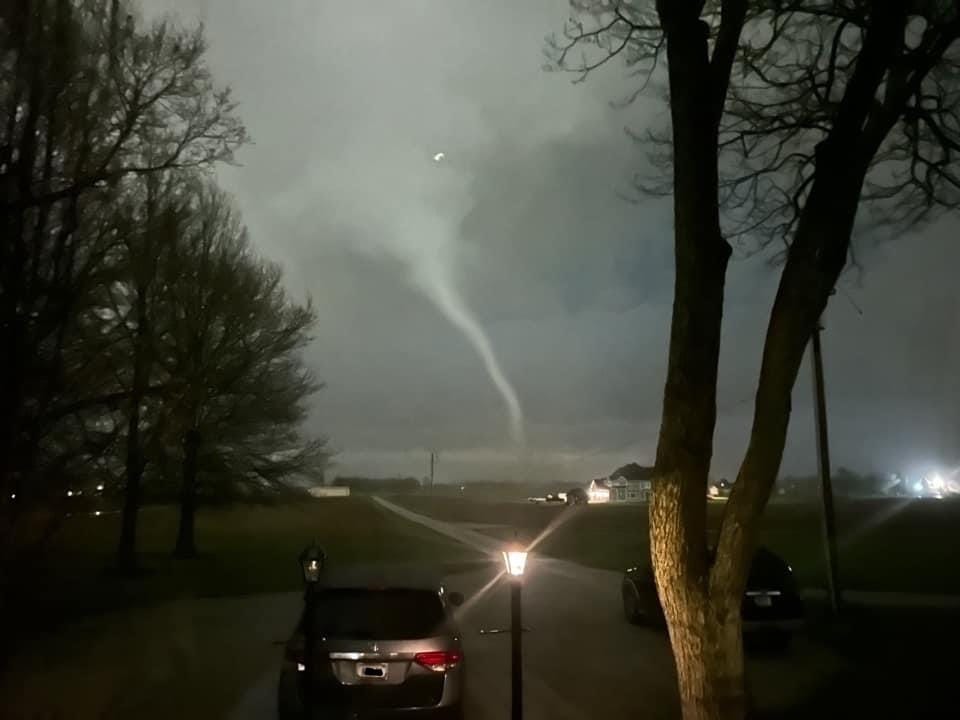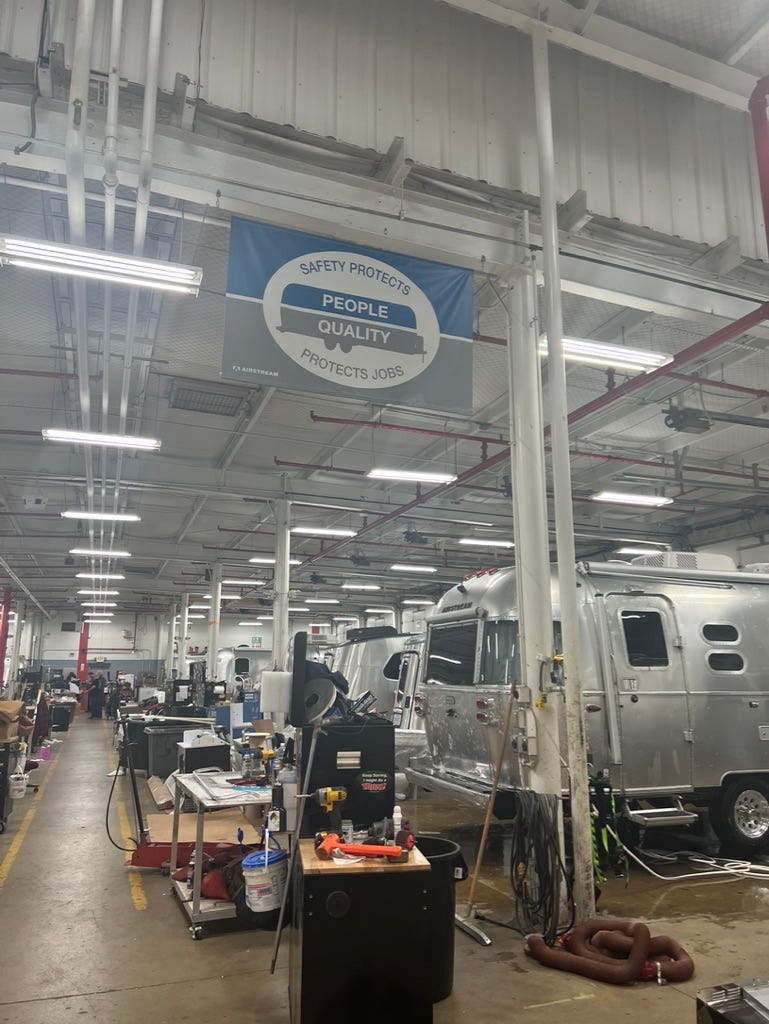The Economics of Fear
A Personal View from America's Heartland
Say fear's a man's best friend
You add it up it brings you down…you add it up it brings you down.
John Cale Fear (1974)
Fear is all around us. Last night, a massive storm hit the entire US Midwest and the Southeast as well. Local networks paused programming, and tornados inflicted damage that has not been fully tallied. Many people spent their evening crouched in basements, hoping the storms would pass them by. In Illinois, a theatre collapsed with more than 200 people inside. Mother Nature can certainly inspire terror, adding catastrophe to an already long list of things we have come to fear over the past few years. To name several sources of recent anxiety, within the domain of human control:
Covid, an enemy we couldn’t see and whose lethality we couldn’t judge.
Concerns about sudden cardiac death etc due to vaccines, and long Covid.
Violence. Here in Chicago, where we choose a new mayor this Tuesday, crime is at an unprecedented level and haunts everyone. Random shootings of the innocent are daily occurrences. Armed robbery sprees are common as well as carjackings, something I only used to fear on trips to South Africa.
Megafear of China and Russia is at a pitch and level I last experienced in grade school. Warmongering is at its height in countries armed with nuclear weapons. Even respectable media ignore all nuances and fan the flames:
De-dollarization, which is a far off prospect at best, multipolarity the new buzzword. Both are code for loss of American financial dominance.
Climate change
Unsupportable debt
Shortages of commodities and food
The end of US democracy, whether Trump wins or loses - depending on where you sit politically
TikTok and crypto, especially for those over 40
Demographic trends, with good reason as both life expectancies (now 76 for American males) and birthrates in the developed world are in freefall.
A doomsday stock market crash, inflation, and the Fed
And finally, to ensure we don’t take any comfort in technology to solve all of these problems, we now are afraid of AI - in other words code:
 𝕏There is no AI apocalypse. Glad to see that the authors quoted in the #AI Pause letter have called out the signers. What legacy company wouldn’t like to hit the pause button on up-and-coming competitors in the name of the “public good”? https://t.co/Smnf2cwMQxSince we've been looking for more things to do, @emilymbender @mmitchell_ai @mcmillan_majora and I wrote a statement about the horrible "letter" on the AI apocalypse, the very first citation of which, was our #StochasticParrots paper. https://t.co/6kFtBcXhZj https://t.co/sntp5YICpC
𝕏There is no AI apocalypse. Glad to see that the authors quoted in the #AI Pause letter have called out the signers. What legacy company wouldn’t like to hit the pause button on up-and-coming competitors in the name of the “public good”? https://t.co/Smnf2cwMQxSince we've been looking for more things to do, @emilymbender @mmitchell_ai @mcmillan_majora and I wrote a statement about the horrible "letter" on the AI apocalypse, the very first citation of which, was our #StochasticParrots paper. https://t.co/6kFtBcXhZj https://t.co/sntp5YICpC @timnitGebru@dair-community.social on Mastodon @timnitGebru
@timnitGebru@dair-community.social on Mastodon @timnitGebru
Before the storms, I took a break from all of this to go to Ohio with my son to pick up his Airstream. It’s an American icon, a travel trailer clad in aluminum that very much looks like an old fashioned airplane, complete with wraparound windows. They are made in Jackson Center, a town close to Columbus, not far from where the new Intel chip factory is being built. They have a museum, and you can take a factory tour which I highly recommend. It is wonderful to see things actually being built and it is obvious that the employees are proud of what they do.
In order to get to Columbus you have to drive through Gary and the steel mills along Lake Michigan. At night you can see the beating heart of American industry, as factory flares light up the sky. Some find it ugly, but I find it inspiringly beautiful. It is amazing to me that human beings can build this kind of complex, a testament to the spirit that created American prosperity. After the Skyway bridge (owned by Australian investors) you continue through Indiana, home of Mike Pence, where agriculture and industriousness combine. Lots of flags and “I love America” signs everywhere, displayed without irony.
About three hours from Chicago is Ft Wayne, Indiana, now a logistics center and the town that gave us Carole Lombard, Bill Blass, and the last CEO of Silicon Valley Bank, Greg Becker. We had dinner at the Liberty Diner, where the Statue of Liberty greets you at the door and the food is both Greek and American. In my case, since I have a Greek grandfather, it was just like Mom’s. It’s the Midwest, so they close at 9 and we were late, but the waitress told us she was in no hurry and meant it. They had thrown out the last pot of coffee, but I didn't really need any. I had a sense of relief, of being removed from the turbulence of the city and the last few years. No masks anywhere, no feeling that I had to look over my shoulder as I got into my car to head to Ohio.
Fifty miles north of the underrated town of Cincinnati is Dayton, Ohio, home of the Wright Brothers. Modern aviation began in Dayton, and many companies still exist in aviation and healthcare, as well as others including Lexis Nexus. It is the birthplace of the cash register and the modern hydraulic pump. At the end of the 19th century, more patents were issued per capita in Dayton than any place in the United States. It is a forgotten innovation hub.
In 1995, the Dayton Agreement, the peace accord between Bosnia-Herzegovina and the former Yugoslavia, was hammered out at the local airbase, Wright-Patterson.
US Diplomat Richard Holbrooke wrote about his 3-week sojourn in Dayton in his book, To End A War:
There was also a real Dayton out there, a charming Ohio city, famous as the birthplace of the Wright brothers. Its citizens energized us from the outset. Unlike the population of, say, New York City, Geneva or Washington, which would scarcely notice another conference, Daytonians were proud to be part of history. Large signs at the commercial airport hailed Dayton as the "temporary center of international peace." The local newspapers and television stations covered the story from every angle, drawing the people deeper into the proceedings. When we ventured into a restaurant or a shopping center downtown, people crowded around, saying that they were praying for us. Warren Christopher was given at least one standing ovation in a restaurant. Families on the airbase placed "candles of peace" in their front windows, and people gathered in peace vigils outside the base. One day they formed a "peace chain," although it was not large enough to surround the sprawling eight-thousand-acre base. Ohio's famous ethnic diversity was on display.
It seems that this spirit contributed to the cessation of hostilities. Perhaps all such negotiations should take place away from centers of power. We certainly need someone to take on the peacemaking role so ably filled by Richard Holbrooke, who should have won the Nobel Peace Prize for his efforts to end that conflict.
My point is the reverse of Hillbilly Elegy, the book written by now Ohio Senator JD Vance. I am impressed by the wealth and abundance of the Midwest, not its poverty. As San Francisco devolves into a hopelessness, perhaps innovation centers will also return to places like Cleveland, which was once the most innovative city on the planet.
This summer, I encourage you to leave the beaten path of New York, Washington, and California in order to see how the American economy really works, and people outside your group think, and in the process leave fear behind. The wars we have been fighting, against Covid and Russia and so on will eventually end, and we will face a new reality that will require a lot of hard work. After the storm is the time to discover and rebuild.
Articles by others on this topic:
Economics of Fear
MJ Bonn, The ANNALS of the American Academy of Political and Social Science, 1946
Victorious generals, it has often been observed, lose a second war because they have shaped their plans after the patterns of past campaigns; victorious statesmen might lose the peace by adopting similar methods. They tacitly assume that history always repeats itself and that they can secure peace in the future by doing what they left undone in the past-without giving much thought to change that war has brought about. They try to save their countries from dangers which are no longer alive. They are unwilling to visualize novel risks inherent in a great upheaval. They look for safety to mechanical arrangements which can easily be made by victors, and will not realize that even in the economic field, which is supposed to be controlled by practical rational consideration, emotions and spiritual conceptions play a decisive part. While they let their own actions be affected by these emotions and permit fear-start fear to sit in on their councils, they imagine that they can order the lives of the vanquished as one blueprints a modern manufacturing plant.
The Economics of Fear
Robert J. Samuelson, Washington Post, Aug 16, 2006
This is an age of glaring contradictions. It's hard to ignore the great disconnect between the rise of terrorism and the relentless advance of the world economy. After Sept. 11, 2001, the reasonable fear was that terrorism and its nasty side effects -- more anxiety, uncertainty and security checks, and higher costs for moving people and cargo -- might cripple economic growth and frustrate the spread of globalization. It hasn't happened. Not yet, anyway.
The Fear Economy: A Theory of Output, Interest, and Safe Assets
Ruchir Agarwal, IMF Working Paper, Sep 9, 2022
This paper presents a fear theory of the economy, based on the interplay between fear of rare disasters and the interest rate on safe assets….A single fear factor can simultaneously (i) generate cross-correlations in output, labor, consumption, and investment consistent with the postwar US economy; and (ii) generates variation in equity prices, bond prices, and a large risk premium in line with the asset pricing data.
Fear and Economic Behavior
Lina Andersson, Working Papers in Economics 819, University of Gothenburg, Department of Economics, 2022
Players’ increased concern with risk in the fearful state of mind causes a strengthened change in behavior that may appear as an overreaction. This observation is in line with empirical and experimental research that finds a ’residual’ change in behavior after bad news or adverse events… In other words, the behavioral response is stronger than what can be explained by traditional factors alone. The residual change in behavior is however consistent with an emotion- based change of the utility function.







